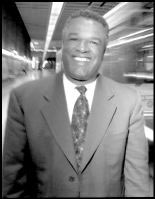LAST WEEK, Al Deright engaged in one of his favorite pastimes. “I was out checking all the unemployment lines and seeing if all those high-paid city employees were standing in line getting new jobs.” As usual, he was disappointed. “I didn’t see any,” he deadpans.
For the last three years, Deright, whose dry wit and Texas twang make him stand out in the chorus of City Hall critics, has been decrying the growth in high-paid jobs in city government. In 1999, there were 615 city workers making over $70,000 a year. Today there are 1,167. Meanwhile, overall city employment has grown from 10,161 in 1998 to 11,028 today.
Due to the downturn in the economy and the tax revolt, city government is now faced with chopping between $30 million and $50 million out of its $650 million general fund budget for next year. Will this be the year City Hall finally makes Deright happy?
Mayor Greg Nickels and his Cabinet held a two-day retreat in La Conner last week, where barren tulip fields no doubt reminded them of their distressing task. They spent a full day just talking about the budget. Dwight Dively, the mayor’s finance director, says the first cuts Nickels wants are in “administration, not direct services.” Dively, a brainy veteran numbers guy, will be performing analyses of the city workforce for the mayor, looking for two kinds of fat: He will look at middle managers to see if the city has built up layers of unnecessary bureaucracy, where supervisors report to senior supervisors who report to sector managers who report to senior sector managers, and so on. Secondly, he will scrutinize the growth of workers who perform analytic functions for departments—planners, specialists, and other technocrats. Nickels “is telling [departments] to look at those things first” when identifying cuts, according to Dively. This would be an important change. In past years, some departments, Dively admits, have cut from the bottom up first, sparing the higher-ups and axing the folks who provide direct services to the public. Last year’s best example, says City Council member Judy Nicastro, was the Parks’ Department proposal to cut back on lifeguards at the city’s swimming pools (it was ultimately defeated).
Nickels also wants Dively to look at “how we do things. Do we have approaches and policies that raise costs?” Dively must also examine what city government does: “Are there whole functions that have less value to the public?” Only after all that will Nickels cut into direct services. Dively asserts, however, that with cuts in the $30 million to $50 million range, “There are going to be service reductions.”
Dively has analyzed the 8.5 percent increase in overall city employment and he argues that the “vast majority” went into direct services: adding firefighters, police officers, librarians, and pothole crews. Of the 867 city workers added in the last four years, 250 went into public safety (police, fire, lawyers, courts); 223 were added to parks, libraries, and at Seattle Center; and 250 wound up in utilities and transportation. Dively admits some could have been managers and analysts.
Given Dively’s acuity, you can bet he will find out. Once Dively comes back with the analysis, will the mayor and City Council have the intestinal fortitude to carry through with these plans? After all, City Hall bigwigs are much more likely to know managers and analysts than cops on the beat and librarians in the stacks.
City Council members including budget chair Jan Drago and President Peter Steinbrueck say they support maintaining direct services and chopping managers and analysts. Last year, however, when City Council member Nick Licata proposed radically reducing the Strategic Planning Office, made up entirely of planners and analysts, he couldn’t round up the necessary votes. Nicastro’s effort to chop high-end workers— people making upward of $80,000—similarly went nowhere during the 2002 budget negotiations. Will this year really be any different?








